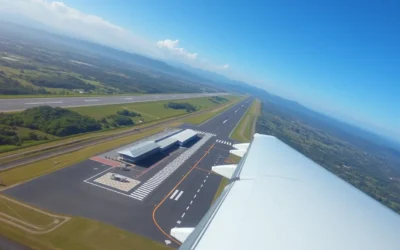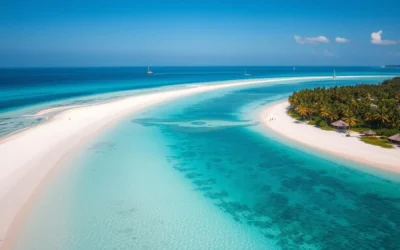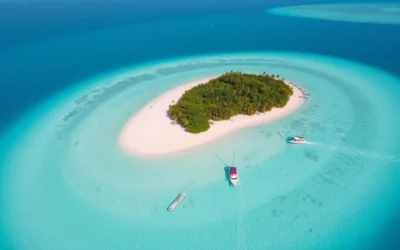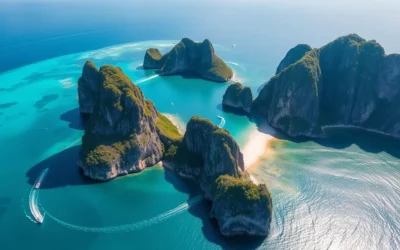✓ Accommodations✓ Flights✓ Rental Cars✓ Tours & Activities
Imagine stepping onto a small island with a rich history, where the echoes of the past meet the beauty of the present. Located at the entrance of Manila Bay, Corregidor Island is a must-visit destination for history enthusiasts and travelers alike.
As you explore this historic gem, you’ll uncover the top attractions and activities that make it a unique experience. From impressive artillery batteries to moving war memorials, Corregidor Island is a living museum of Philippine-American military history.
Whether you’re planning a day trip from Manila or an overnight stay, this comprehensive guide will help you navigate the island’s rich historical landscape and natural beauty, ensuring that you make the most of your visit to “The Rock.”
Discovering Corregidor Island: A Historical Paradise
As you step onto Corregidor Island, you’re immediately immersed in a rich tapestry of history, natural beauty, and adventure. This small island, located at the mouth of Manila Bay, is a treasure trove of historical significance, offering a unique travel experience that combines education and leisure.
The Strategic Importance of “The Rock”
Corregidor Island, affectionately known as “The Rock,” played a pivotal role during the Pacific War due to its strategic location. Officially called Fort Mills during the American era, it was the largest of the heavily fortified islands defending Manila Bay. The island’s terrain and fortifications earned it the nickname “Gibraltar of the East.” Understanding its historical significance provides context to the Philippines’ complex past and its relationship with the United States and Japan.

Why Corregidor Should Be on Your Philippines Itinerary
Corregidor stands out among Philippine tourist spots due to its unique blend of historical significance and natural beauty. Visitors can explore preserved structures, enjoy guided tours, and appreciate the island’s untouched landscapes. Whether you’re a history enthusiast, photography lover, or adventure seeker, Corregidor offers a compelling experience. It’s an ideal destination for those looking for a different kind of trip, one that is both educational and adventurous.
| Attraction | Description | Interest |
|---|---|---|
| Historical Landmarks | Preserved structures from the Pacific War era | History Enthusiasts |
| Natural Beauty | Untouched landscapes and scenic views | Nature Lovers |
| Guided Tours | Informative tours providing historical context | Adventure Seekers |
By visiting Corregidor, you’re not just going on an adventure; you’re stepping into an open-air museum where history comes alive. It’s an experience that enriches your understanding of the Philippines’ past, making it a must-visit destination on your Philippines itinerary.
How to Get to Corregidor Island
If you’re wondering how to get to Corregidor Island, you’re in the right place. Corregidor Island is a historical paradise located near Manila, and there are several ways to get there.

Day Tours from Manila via Sun Cruises
One popular way to visit Corregidor Island is by taking a day tour from Manila via Sun Cruises. This option allows you to enjoy the island’s historical attractions without the hassle of planning transportation.
Sun Cruises offers a convenient and relatively quick way to reach Corregidor, making it an ideal choice for those with limited time. You can enjoy a day filled with exploring the island’s WWII history and scenic views.
Alternative Routes from Bataan
For those looking for an alternative, consider traveling from Bataan province. You can stay at one of the best resorts in the area, such as Camaya Coast Beach Resort, and then take a ferry to Corregidor Island.
This route not only offers a shorter boat ride but also allows you to experience the historical significance of Bataan. Travel Tales offers a combined tour package that includes a visit to Corregidor Island and a stay at Camaya Coast Beach Resort, a beautiful beach resort with amenities like an infinity pool and water inflatables.
Battery Way: Impressive Artillery Emplacements
One of the top things to do on Corregidor Island is visiting Battery Way, a historical military installation that showcases impressive artillery emplacements. Built from 1904 to 1914, Battery Way is one of the two mortar batteries at Fort Mills, named after Lt. Henry Way of the 4th US Artillery.

The Historical Significance of Battery Way
Battery Way holds significant historical importance as it features four 12-inch mortars capable of lobbing a 1000-lb deck-piercing shell or a 700-lb high explosive shell 14,610 yards in any direction. This artillery installation played a crucial role in the island’s defensive strategy during its operational years. As a key point of interest on the island, it provides insight into the military history of Corregidor.
What to See at This Military Installation
During your tour of Battery Way, you’ll have the opportunity to explore well-preserved gun emplacements, getting up close to these massive weapons. You can learn to identify the different parts of the mortar battery and understand how soldiers operated these complex weapons. The installation offers great spots for photography, especially when capturing all four mortars in a single frame. Visiting at the right time of day can enhance your experience, as the installation can get hot during midday. Understanding the role of Battery Way in the broader defensive strategy of Corregidor adds depth to your visit.
Mile-Long Barracks: The Longest Military Barracks
Corregidor Island’s Mile-Long Barracks is an iconic ruin that offers a glimpse into the island’s rich military history. This three-story concrete building, measuring 1,520 feet long, was used for the billeting of American officers and enlisted personnel. According to your tour guide, walking through its three levels gives you a good workout, covering a distance of almost a mile, hence its name.

The Iconic Skeletal Ruins
The skeletal remains of the Mile-Long Barracks are a poignant reminder of the island’s wartime past. As you explore the area, you’ll notice the barracks’ imposing structure, a testament to the engineering skills of the time. The barracks have become an iconic symbol of Corregidor Island, often featured on postcards and magazine covers.
Photography Tips for Capturing the Barracks
Capturing the essence of the Mile-Long Barracks through photography can be a rewarding experience. For the best shots, consider visiting during the early morning when the light casts dramatic shadows through the empty window frames. Experiment with wide-angle shots to convey the scale of the structure. Be sure to explore the surrounding area to find vantage points that offer striking views of the barracks against the backdrop of the sea or jungle.
| Photography Tip | Description |
|---|---|
| Early Morning Light | Dramatic lighting through empty window frames |
| Wide-Angle Shots | Capture the scale and length of the barracks |
| Vantage Points | Find striking views against the sea or jungle backdrop |
As you take a tour of the Mile-Long Barracks, remember to be mindful of your surroundings and respect any safety guidelines provided by your guide. A bit of planning and creativity can go a long way in capturing memorable photos of this historical landmark.
Pacific War Memorial Complex: Honoring the Fallen
Perched atop the island’s highest point, the Pacific War Memorial Complex stands as a powerful tribute to the fallen. This complex is a poignant reminder of the sacrifices made during World War II and is a must-visit destination on your Corregidor Island tour.
The Memorial Dome and Eternal Flame
The Pacific War Memorial Complex is home to the striking Memorial Dome, a circular altar illuminated by sunlight streaming through the oculus above. This architectural marvel is a poignant tribute to the Filipino and American soldiers who served during World War II. Adjacent to the dome is the Eternal Flame of Freedom Monument, designed by sculptor Aristides Dimetrios, symbolizing the undying spirit of liberty.
The Memorial Dome’s design allows natural light to highlight the altar, creating a serene atmosphere for reflection. The Eternal Flame of Freedom Monument serves as a reminder of the sacrifices made during the war, and its presence adds a layer of emotional depth to the memorial complex.
Exploring the Pacific War Memorial Museum
The Pacific War Memorial Museum is an integral part of the complex, housing a comprehensive collection of World War II artifacts, photographs, and documents. As you explore the museum, you’ll discover key exhibits that chronicle the fall of Corregidor, the subsequent Japanese occupation, and the eventual liberation of the Philippines.
The museum’s interactive displays and informative panels provide a deeper understanding of Corregidor’s role in the broader Pacific Theater of World War II. You’ll also have the opportunity to learn about the personal stories and testimonies of soldiers and civilians, bringing the historical events to life beyond mere dates and facts.
When planning your visit, be sure to allocate sufficient time to fully appreciate the museum’s offerings. Guided tours are available, and it’s recommended to check the museum’s hours of operation to make the most of your visit.
Malinta Tunnel: Corregidor’s Underground Fortress

As you explore Corregidor Island, one of the most fascinating historical sites you’ll encounter is the Malinta Tunnel. This underground fortress is a significant historical landmark that offers a glimpse into the island’s past.
The History Behind the Name
The Malinta Tunnel’s name is derived from the Samal word “malinta,” meaning “many tunnels.” Indeed, the complex features an extensive network of tunnels and chambers. The main tunnel served as a theater for the Lights and Sound show, an audio-visual presentation created by National Artist Lamberto Avellana. This show narrates the key events of the battle in Corregidor, providing visitors with a deeper understanding of the island’s historical significance.
The Lights and Sound Show Experience
The Lights and Sound show is a 30-minute dramatization that uses lighting effects, recorded voices, and sound effects to recreate key moments from Corregidor’s wartime history. While some visitors might find the presentation a bit dated or underwhelming, others appreciate its historical value and the unique atmosphere of experiencing it inside the actual tunnel. For a more enjoyable experience, consider bringing a light jacket, as the underground environment can be cool compared to the tropical heat outside.
To make the most of your visit, be aware that the Lights and Sound show comes with an additional fee of approximately P200. It’s advisable to check the show schedules and incorporate it into your day tour itinerary. By doing so, you’ll enhance your understanding and appreciation of Corregidor Island’s rich history.
Japanese Garden of Peace: A Place of Reconciliation
As you explore Corregidor Island, you’ll discover a poignant spot that embodies the spirit of reconciliation. The Japanese Garden of Peace is a serene area that serves as a memorial to the Japanese soldiers who fought on the island during the war. This garden is part of the island’s complex history, representing a significant step towards healing and peace.
The Symbolic Buddha Statue
The garden is home to a striking 10-ft tall stone statue of Buddha, facing the direction of Japan. This symbolic figure is a fertility Buddha, adding a layer of depth to the garden’s meaning. The statue, along with the Shinto Shrine, creates a contemplative atmosphere, inviting visitors to reflect on the human cost of war.

Reflecting on War and Peace
As one of the most thought-provoking spots on the island, the Japanese Garden of Peace offers a unique juxtaposition with other American and Filipino memorials. Funded by the Japanese government, this garden is a testament to international efforts towards reconciliation. It stands as a powerful reminder that Corregidor has transformed from a battlefield to a place where former enemies can honor their fallen together, fostering a sense of peace and unity.
Filipino Heroes Memorial: Honoring Local Bravery
Corregidor Island is home to the Filipino Heroes Memorial, a 6000-square meter site dedicated to the memory of Filipino soldiers who fought valiantly during World War II. Designed by Francisco Mañosa, this memorial is a significant addition to the island’s historical landscape.
The Manuel Casas Murals
The memorial’s main attraction is the 14 murals sculpted by Manuel Casas, depicting the battles and sacrifices of Filipino soldiers. These murals are not only a testament to the artistic skill of Casas but also serve as a poignant reminder of the bravery and resilience of Filipino heroes.
Paying Respect to Filipino Soldiers
Visitors to the memorial can pay their respects to the Filipino soldiers who played a crucial role in the island’s history. The site includes commemorative plaques and informational displays that provide context to the murals and the history they represent. As you explore the memorial, you can reflect on the significance of the sacrifices made by these soldiers.
| Memorial Features | Description |
|---|---|
| Manuel Casas Murals | 14 murals depicting battles and sacrifices of Filipino soldiers |
| Commemorative Plaques | Providing context to the murals and the history they represent |
| Informational Displays | Offering insights into the significance of the memorial and its elements |

Corregidor Island, Philippines: Best Things to Do Beyond History
As you explore Corregidor Island, you’ll discover that its natural beauty is just as captivating as its historical importance. Beyond the historical landmarks, the island offers a variety of activities and attractions that make for a well-rounded trip.
Beaches and Natural Attractions
The island is home to beautiful beaches and natural attractions. Although the hotel is situated along South Beach, visitors often find that the break is too short for a leisurely swim or beach activities. Nonetheless, the area is worth exploring for those looking to enjoy the water and relax in a serene environment.
- Explore the island’s coastline and discover secluded spots.
- Enjoy the tranquility of the island’s natural surroundings.

Wildlife and Nature Exploration
Corregidor Island is a haven for nature lovers and adventure seekers. The island boasts a surprising biodiversity, with various bird species, monkeys, monitor lizards, and other wildlife. Visitors can explore the island’s trails and viewpoints to get a glimpse of its natural beauty.
- Discover the island’s diverse wildlife and ecosystems.
- Learn about the best trails and viewpoints for nature exploration.
- Understand how the island’s ecosystem has recovered since World War II.
By exploring Corregidor Island’s natural attractions, you can add a new dimension to your trip and create lasting memories of your adventure in this unique area.
Practical Tips for Visiting Corregidor Island
With its rich history and scenic spots, Corregidor Island is a unique destination that requires some preparation to fully appreciate. As you plan your visit, consider a few practical things to make your trip more enjoyable.
Best Time to Visit
The best time to visit Corregidor Island is during the dry season, from November to April, when the weather is more favorable for exploring the island’s historical sites. A bit of planning can help you avoid the crowds and make the most of your day tour or longer stay.
What to Bring and Wear
When visiting Corregidor, it’s essential to wear comfortable clothing and shoes suitable for walking. Don’t forget to bring sun protection, such as a hat, sunglasses, and sunscreen, as well as a camera to capture the memorable things you’ll see. Be prepared for a bit of sea spray if you plan to visit the beach areas.

Photography and Etiquette Tips
As you explore Corregidor’s historical sites and memorials, be mindful of photography etiquette. While it’s encouraged to take photos of the island’s iconic structures, such as the Mile-Long Barracks and Pacific War Memorial, be respectful of areas that commemorate those who lost their lives. After your visit, consider sharing your experiences and photos on social media to post about your incredible journey.
By following these practical tips, you’ll be well-prepared to appreciate the historical significance and natural beauty of Corregidor Island during your visit.
Overnight Stays: Extending Your Corregidor Experience

An overnight stay on Corregidor Island offers a unique perspective on this historical site. While day tours provide a glimpse into the island’s rich history, staying overnight allows you to experience it in a different light.
Accommodation Options on the Island
The Corregidor Hotel is the primary accommodation option on the island. You’ll have your meals here, including lunch at the La Playa Restaurant, which serves a variety of dishes including paella. Although the food is not exceptional, it is satisfying. The hotel provides basic yet comfortable lodging, making it an ideal choice for those looking to spend more time on the island.
Benefits of Staying Overnight
Staying overnight on Corregidor Island has several benefits. You can witness the island’s transformation at sunset and sunrise, offering spectacular photo opportunities. The absence of day tour crowds in the evening allows for a more relaxed exploration pace. You can also engage in evening activities such as stargazing or special historical presentations. Moreover, having more time on your hands enables you to visit areas not covered by standard day tours, giving you a deeper connection to the island’s history and atmosphere.
As you enjoy the tranquility of the island at night, you’ll appreciate the unique advantage of experiencing Corregidor after the day tour crowds have departed on the afternoon boat back to Manila. With the water surrounding the island and the occasional sound of the boat in the distance, the ambiance is truly serene.
Conclusion: Why Corregidor Island Deserves Your Visit
As one of the most significant WWII sites in the Pacific, Corregidor Island provides a unique blend of history, education, and adventure. Your visit to this island will be a memorable one, with its well-preserved ruins and guided tours offering a glimpse into a pivotal moment in history.
The island’s historical significance is palpable as you explore its many historical spots, including the Pacific War Memorial Complex and the Malinta Tunnel. These sites offer a tangible connection to the events that shaped modern history, making Corregidor Island an educational experience like no other.
Beyond its historical importance, Corregidor Island also boasts natural beauty, with various beach areas and opportunities for boat tours. This balance of somber remembrance and natural beauty makes it an appealing destination for a wide range of interests.
When planning your trip to the Philippines, consider including Corregidor Island in your itinerary, whether as a day tour from Manila or as part of a broader historical tour. With its unique blend of history and natural beauty, it’s a must-visit destination that deserves a spot on your travel bucket list.
As you share your experience on social media, remember to be respectful of the island’s historical significance. Your post can help raise awareness about the importance of preserving historical sites like Corregidor Island.
In conclusion, Corregidor Island is more than just a tourist spot; it’s a reminder of the cost of war and the value of peace. Even a brief visit can leave a lasting impression and a deeper appreciation for the sacrifices made during WWII. Consider planning your trip to coincide with commemorative events to add another dimension to your experience.
The above is subject to change.
Check back often to TRAVEL.COM for the latest travel tips and deals.






